Confederate Army
Confederate Army Command
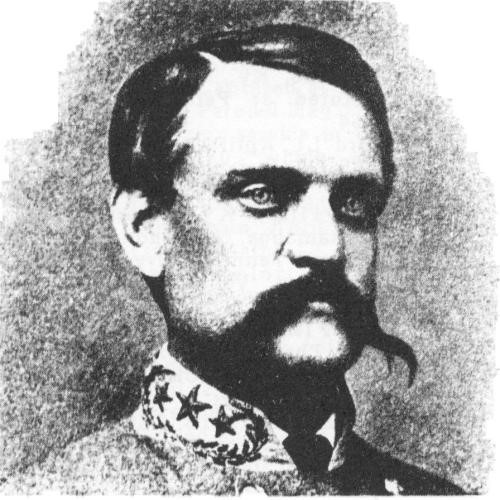 Commander of Confederate Department of Western Virginia
Commander of Confederate Department of Western Virginia
Born: 1821
Where: Lexington, Kentucky
Field of Study: Law
Military Service: He was appointed as major in the 3rd Kentucky Infantry with the opening of hostilities with Mexico. He marched with the 3rd to Mexico City in 1847 but saw no combat there.
Political Career: He won a seat in the Kentucky legislature in 1849 and beat General Leslie Combs for a congressional seat in 1851. Breckinridge, a Democrat, was re-elected to a second term in 1853. He retired from politics two years later with many friends in Washington. He was nominated in 1856 as James Buchanan's running mate at thirty-five years of age. The election won made him the youngest vice president in US history.
His politics were moderate and did not favor secession. He reluctantly accepted a bid for President in the Election of 1860. Breckinridge came in second in the Electoral College to Lincoln. He was a senator until well after the guns of Sumter had sounded. In September of 1861, his harsh views against President Lincoln's war made him unpopular back home. He left Washington and went into a Confederate uniform.
Civil War Military Service: He was commissioned a brigadier general and served with Confederate forces in the Western Theater. He fought in the battles of Shiloh, Corinth, Vicksburg, Baton Rouge, Stones River, Jackson, and Chickamauga. In 1863 he was promoted to major general and briefly commanded a corps in Bragg's Army of Tennessee. Breckinridge did not get along with his commander, and the War Department chose to transfer him east to Western Virginia. He was appointed to command the Department of Western Virginia on February 25, 1864. He arrived at his new headquarters at Dublin, Virginia on March 4 to assume command the next day. He began with an inspection tour of his command that took him several hundred miles on horseback. He began with a regular drill for the men, officer instruction and strict discipline to combat desertions.
On May 1 Breckinridge received a dispatch from Lee…" it will be impossible to send any reinforcements to the Valley from this army." He found out that Averill was coming out of West Virginia towards Staunton. On May 4 Breckinridge received a message from Richmond. It stated "Information received here indicates the propriety of your making a junction with General Imboden to meet the enemy on his movements toward Staunton. Communicate with General Lee and General Imboden." It was sent from the highest authority, President Jefferson Davis.
He was ready to move out to meet Averill on May 4 with three brigades of infantry, about 4000 men, and 2600 troopers. He found out that day that Averill was not his only adversary; Sigel was on the move and threatened the entire Valley. Breckinridge waited for orders from General Lee, which came at 5:00 A.M. on May 5. Lee ordered Breckinridge to meet Sigel and drive him north before his own left flank was imperiled. The general sent orders immediately to congregate his force by rail at Staunton. He reached the Town of Staunton on the evening of May 8 after a long day in the saddle. He received distressing news that Crook was only a few miles from his headquarters at Dublin Depot. His reserves were there to offer Crook a…"warm reception" near Cloyd's Mountain.
He started off again north on May 13 with orders to move issued for 6:00 A.M. On the 14th his army marched to Lacey Spring, just south of New Market. Orders from Breckinridge were issued to begin marching north at 1:30 A.M. At 3:00 A.M. Breckinridge woke General Imboden up at his headquarters. The CS forces established a line along Williamson's Hill and began to fortify it with rail field works. It was finished around dawn on May 15. This line was important as a defensive position in case of a withdrawal.
Breckinridge ordered Imboden to attack the Union lines a fall back creating a demonstration. An artillery section under Berkley was sent to the crest to fire on the Union line. The general personally went to the crest of Shirley’s Hill to inspect the damage from the guns. Imboden was summoned to the hill and he and the commanding general surveyed the ground in front of them. He received good news on that hill that his reserves had defeated Averill and Crook was no longer a threat. The general stated to Colonel Edgar… "Well, I have offered him battle and he declines to advance on us". He turned to Imboden…"We can attack and whip them here and I'll do it." He ordered his troops into the new Shirley's Hill position at 10:00 A.M. Twelve cannon were placed atop the hill and were delivering a withering fire on the enemy positions. He met with Scott Shipp and told him that …" should the occasion require it, he would use them very freely." His lines formed, he began to shift his forces in plain sight of the enemy to confuse them around 11:00 A.M. A short time later the skirmishers of the 30th Virginia went down the hill towards the 18th Connecticut Infantry. The general met again with the cadets in the rear. He told them” Young gentlemen, I hope there will be no occasion to use you, but if there is, I trust you will do your duty.”
With all of his forces down along the New Market Valley, he reformed his men for the advance up the hill. The town was firmly in Confederate hands again by about 12:30 P.M. Breckinridge moved his artillery along a series of elevations east of pike. This position allowed the artillery to fire in front and obliquely at the Union lines. He allowed Imboden to continue with the plan to cross Smith’s Creek and burn the bridge over the North Fork of the river. Just before 2:00 P.M., the Confederate lines moved north again under a fierce Union shelling.
Imboden remembered that the general was with the men during the battle. He was ...”steadying them everywhere by his personal presence.” Another soldier, Lieutenant James Clay remarked that “General Breckinridge is the bravest man I ever saw. He is not afraid to go anywhere in the world. “He had chosen to advance his force with two lines in echelon. He eventually moved over to the east of his lines to join Chapman’s Battery. The captain was ordered to “move his guns to the front where they could kill somebody.” The general had found a good observation point there and spent most of his time in that sector of the field.
The time was almost a quarter to three O’clock. The Confederate lines along Bushong’s wheat field were being devastated by canister fire from the left and center. A gap appeared between the 51st Virginia and the 62nd Virginia. A startled Major Charles Semple found the general with the guns and pleaded for support from the reserves. He said “General, why don’t you put the cadets in line? They will fight as well as our men.” The general replied “No Charley, this will not do, they are only children and I cannot expose them to such a fire as our center will receive.” The major remarked …”The Federal are right on us. If the cadets are ordered up, we can close the gap in our center.” Breckinridge made it official, “Put the boys in…and may God forgive me for the order. By 3:00 P.M., the US advance is shattered and the cavalry charge from the east is turned back. The Confederate line moved forward with the Cadet Battalion making up the center. The Federal rout had begun. The cadets captured one of Von Kleiser’s 12 l/b Napoleon’s directly in front of their position.
Breckinridge found Colonels Smith and Patton on foot behind their respective lines. The general dismounted Old Sorrel and offered it to the officers. He remarked to them …”I do not feel like riding, when you gentlemen who have borne the brunt of the fight are walking.” He was turned down and walked his subordinates for a while. He mounted again and rode over to the cadet position. He told them, “Young gentlemen, I have to thank you for the result of today’s operations. “ The order came to send them to the rear at almost thirty minutes past the hour. The general said to them “Well done, Virginians! Well done, men!
Around this time a regular army officer named Captain Henry DuPont and his battery of 3” rifles slowed Breckinridge’s advance. He deployed them in a staggered formation along the pike and began to retire by platoons towards Rude’s Hill. General Breckinridge let the ranks rest for almost an hour to let the trains come forward with ammunition. General Imboden returned to his lines without crossing the creek and without firing the bridge of the North Fork. The general moved his men and guns forward to pursue the Federals and to silence DuPont. The pursuit continued up the South crest of Rude’s Hill and down through Meem’s Bottom to the river bridge. The rout continued until Union soldiers crossed and fired the bridge around 7:00 P.M.
With Sigel in fast retreat down the Valley, Lee ordered Breckinridge to move the bulk of his men to Staunton and the Virginia Central Railroad. He would be moved east to join the Army of Northern Virginia. The army boarded cars for the trip to Hanover Junction on May 19.
Breckinridge led his brigades at the battles of North Anna and Cold Harbor. An enemy shell during the campaign killed his famed war-horse, Old Sorrel. The general was injured in the fall. He came back to Valley to operate against General Hunter. He was unable to walk but still established a defense for the City of Lynchburg. He commanded a corps in Early’s Army of the Valley and led it to Martinsburg on July 4 against his old adversary, Franz Sigel. His division under Gordon fought well at the battle of Monocacy July 11-12, 1864. Breckinridge fought in small engagement at Kernstown against Crook and was with Early at Winchester on September 19. He received orders to return to the Department of Southwestern Virginia to repel several raids and lead one of his own.
In January of 1865 he was called east for a new assignment, Secretary of War. It was made official on February 6. He organized the evacuation of Richmond on April 2 and sat in on the surrender proceedings between General Sherman and General Johnston at Durham Station, North Carolina. He escaped through Georgia, Florida and across the straits to Cuba.
He spent the next three and a half years in exile in England, Europe and Canada. In February 1869 he returned to the United States and went home to Lexington, Kentucky. He worked with a new railroad there and served as president of a life insurance company. He was openly against the Ku Klux Klan. Breckinridge became sick and passed away on May 17, 1875, just two days from the anniversary of his great victory at New Market. He was fifty-four years of age.
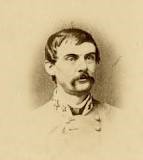 Source: Generals in Gray
Source: Generals in Gray
John Echols was born in Lynchburg, Virginia, March 20, 1823, and was graduated from Washington College. He studied law at Harvard and was admitted to practice in 1843. Prior to the Civil War, he was commonwealth’s attorney, a member of the general assembly, and a delegate to the secession convention. After recruiting service in the western counties, Echols commanded the 27th Virginia Infantry at First Manassas with a rank of Lt. Colonel, and was shortly afterwards promoted colonel. He was severely wounded at Kernstown during the Valley campaign of 1862, and was commissioned brigadier general to rank from April 16, 1862.
His later service was almost entirely in Western Virginia (exception Cold Harbor) during which he participated in numerous engagements including the Battle of New Market. After the war, General Echols became a prominent businessman in Staunton, Virginia, and Louisville, Kentucky, helping to organize the Chesapeake and Ohio Railway out of the old Virginia Central, and serving on the board of visitors of the Virginia Military Institute and Washington and Lee University. A huge man, six feet four inches tall and weighing two hundred and sixty pounds, he was said to have rarely made an enemy and never lost a friend. He died in Staunton, May 24, 1896, and is buried there.
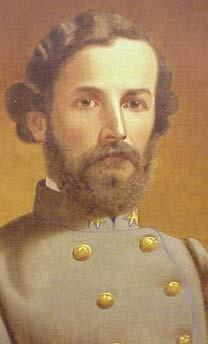 "Col. George Patton Sr. (June 26, 1833 – September 25, 1864) was a Confederate colonel during the American Civil War. He was the grandfather of World War II general George S. Patton. George Patton was also the great-grandfather of Major General George Smith Patton, who died in 2004.
"Col. George Patton Sr. (June 26, 1833 – September 25, 1864) was a Confederate colonel during the American Civil War. He was the grandfather of World War II general George S. Patton. George Patton was also the great-grandfather of Major General George Smith Patton, who died in 2004.
When the American Civil War broke out, he served in the 22nd Virginia Infantry of the Confederate States of America, rising from captain to colonel of the regiment. As lieutenant colonel he was wounded in the shoulder at the Battle of Scary Creek in present-day West Virginia on July 17, 1861 [2]. He was again wounded at Giles Court House, this time in the stomach. At the Battle of Opequon, also known as the Third Battle of Winchester, he was mortally wounded and died September 25, 1864." (From Wikipedia - Read more).
Source: Find a Grave:
"Col. Clarence Derrick died at Greensboro, Ala., on December 9, 1907, in his seventy-first year. He was born in Washington, D.C., and was appointed by President Buchanan a cadet "at large" to West Point in September, 1857, graduating from there in June, 1861, fourth in his class. He resigned from the United States army in July, and entered the service of the Southern Confederacy as a regular officer of artillery."
Cadet Clarence Derreck, USMA Class of 1861.
Classmate of Captain Henry A. DuPont, 5Th US Artillery
Source: Find a Grave:
"LTC George M. Edgar 26th Battalion, 1st Brigade, Army of the Southwest Va. CSA also held many professorships throughout the south. He was born in Union (Va) W.Va. in 1837, attended the local academy, then graduated from VMI in 1856. He was an asst. professor at VMI and then taught in Florida. He enlisted as a private in the 1st Fl. Regt. but was promoted to 1st Sgt. When the civil war broke out he resigned and returned to Va. and helped raise a company of men in which he eventually became capt. (59th Va.)"
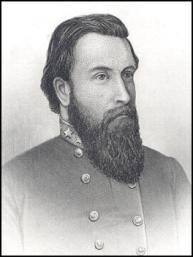 Source: Generals in Gray
Source: Generals in Gray
Gabriel Colvin Wharton was born on July 23, 1824, in Culpeper County, Virginia. He was graduated second in the class of 1847 at the Virginia Military Institute. He then took up the profession of civil engineering and spent a number of years before the Civil War in Arizona, where he had joined mining interests. Elected major of the 45th Virginia Infantry in July 1861, he became colonel of the 51st Virginia Infantry the following month. He led his regiment in General John B. Floyd's Western Virginia campaign of that summer and fall. Escaping with Floyd from Fort Donnellson in February 1862, he was transferred east. He served under Generals Loring and Samuel Jones, again in the western part of Virginia, and was promoted to brigadier general. He was given temporary command of the Valley District, and was General Longstreet in East Tennessee in the winter and spring of 1863-64. He commanded his brigade at New Market and in the pursuit of Hunter; and also fought with it under General Early in the Shenandoah campaign and in the raid on Washington. His command was overwhelmed and dispersed at Waynesboro in March 1865. He was finally paroled at Lynchburg on June 21.
At the close of the war, General Wharton took up residence in Radford, Virginia, where he lived for more than forty years. Elected several times to the state Senate, he devoted much time to the development of mining in the state, and died in Radford on May 12, 1906. He is buried there in the family cemetery.
BATTLE UNIT NAME: 30th Battalion, Virginia Sharpshooters (Clarke's)
SIDE: Confederacy
COMPANY: F&S
SOLDIER'S RANK IN: Lieutenant Colonel
SOLDIER'S RANK OUT: Lieutenant Colonel
ALTERNATE NAME:
FILM NUMBER: M382 ROLL 11
PLAQUE NUMBER:
NOTES: none
BATTLE UNIT NAME: 51st Regiment, Virginia Infantry
SIDE: Confederacy
COMPANY: F&S
SOLDIER'S RANK IN: Captain
SOLDIER'S RANK OUT: Lieutenant Colonel
ALTERNATE NAME:
FILM NUMBER: M382 ROLL 61
PLAQUE NUMBER:
NOTES: Company Note - A
"In 1861 Smith entered the Confederate States Army on June 11 as a Private in the Pendleton Rifles, which became Company E of the 25th Virginia Infantry. Elected as Captain on July 1, he and his men were part of the surrender after the Battle of Rich Mountain. Being paroled 2 weeks later he was formally exchanged in March 1862, and was elected as Colonel of his regiment. He was wounded in the Battle of McDowell and received another wound at the Second Battle of Bull Run. After recovering in late 1862 Smith was ordered by the War Department to take several hundred newly exchanged soldiers to Colonel John D. Imboden for service in western Virginia, and was offered the command of them. In January 1863 he became Colonel of the new 1st Regiment Virginia Partisan Rangers, that became the 62nd Virginia Mounted Infantry,[2] as part of General Imboden's Cavalry Brigade and took it into the Jones-Imboden Raid.
In June 1863 the brigade went North, and took part in the Gettysburg Campaign as part of Imboden´s Command that covered the retreat into Virginia. Smith and his men spent the rest of 1863 and early 1864 scouting and skirmishing in northwestern Virginia. While Smith acted as brigade commander on behalf of General Imboden he was transferred with his (now dismounted) regiment to the forces of General John C. Breckinridge. He participated in the battles of New Market and Cold Harbor. Rushing to take part in the Lynchburg Campaign Colonel Smith and his regiment were reassigned to General Imboden and mounted again; and took part in the further Valley Campaigns of 1864. When General Imboden was struck with typhoid fever Smith took command of the brigade on July 5 and reassumed it several times till the end of the war. Being nominated for a promotion to Brigadier General by his division command General Lunsford L. Lomax the nomination was at first vetoed by General Lee. Later on in 1865 General Lee endorsed the promotion, but it was too late in the war to be realized." (From Wikipedia - Read more)
Confederate Army Command
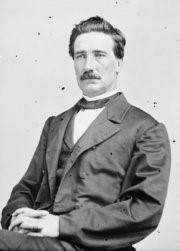 Source: Generals in Gray
Source: Generals in Gray
John Daniel Imboden was born near Staunton, Virginia, February 16, 1823. He attended a country school until his sixteenth year, after which he had two terms at Washington College. Thereafter he taught school for a time, studied law, and opened an office in Staunton. He was twice the representative of his district in the legislature and an unsuccessful candidate for the Virginia secession convention.
He entered Confederate service at the very beginning of the war as captain of the Staunton Artillery, a light battery which he commanded at the initial capture of Harper's Ferry. After service at First Manassas, he organized the 1st Virginia Partisan Rangers (later called the 62nd Virginia Mounted Infantry) and took part in the battles of Cross Keys and the Port Republic under Stonewall Jackson. Promoted brigadier general to rank from January 28, 1863, Imboden conducted a famous raid into Northwestern Virginia, where he severed the Baltimore and Ohio Railroad and captured several thousand cattle and horses. On the retreat from Gettysburg, he was instrumental at Williamsport in saving the trains of the army. He later captured the garrison at Charlestown, West Virginia, and fought gallantly during Early's Valley Campaign of 1864, General Imboden served during the balance of the war on prison duty at Aiken, South Carolina, following which he settled in Richmond and resumed his law practice. During the later years of his life, he resided in Washington County, Virginia, where he pioneered in developing the mining resources of the area. His death occurred at Damascus, a small town which he had founded, on August 15, 1895; he is buried in Richmond.
Born in Augusta County, Virginia, George William Imboden (June 25, 1836-January 8, 1922) became a distinguished attorney, Confederate soldier, and a leading citizen of Ansted. After attending Staunton Academy, he studied law and was admitted to the bar in 1858. In 1859, he married Mary Frances Tyree, daughter of an Ansted innkeeper. Imboden enlisted in the Southern service on April 17, 1861. He rose to the rank of colonel by December 1862, when he took command of the 18th Virginia Calvary which fought at Chancellorsville and in many other battles. He was seriously wounded at Gordonsville, Virginia.
Moving to Fayette County in 1870, Imboden actively promoted industrialization of the two Virginias. His older brother and business partner, Gen. John D. Imboden, had already established himself politically in Virginia. George acted as attorney and served as a director of the Gauley Mountain Coal Company, the Loup Creek Colliery, and the Deepwater Railway.
Imboden served Ansted and Fayette County from 1870 to 1922, holding office in the House of Delegates (1876), as president of the Fayette County Commission (1881–85), first mayor of Ansted (1891–92), and town recorder (1891–1907). A tall, slender man with piercing eyes and a no-nonsense military demeanor, he married Angia M. Dickinson, daughter of a Fayette County pioneer in 1869, after the death of his first wife. George W. Imboden died at home and was buried in Confederate gray in Westlake Cemetery. His home in Ansted, known as Contentment, is a National Register property that now serves as a Fayette County museum.
RELATED ARTICLES
Civil War Sources
Peters, J. T. & H. B. Carden. History of Fayette County. Charleston: Jarrett Printing, 1926.
Delauter, Roger U. Jr. 18th Virginia Cavalry. Lynchburg: H. E. Howard, 1985.
Woodward, Harold R. Jr. Defender of the Valley: Brigadier General John D. Imboden, CSA. Berryville, VA: Rockbridge Publications, 1996.
Beckelheimer, Christine. "George W. Imboden," in , History of Fayette County. Fayetteville: Fayette County Chamber of Commerce, 1993.
Athey, Lou "George W. Imboden." e-WV: The West Virginia Encyclopedia. 04 December 2012. Web. 06 May 2020.
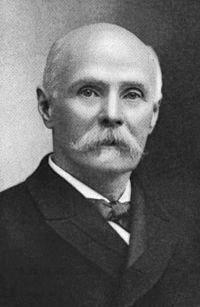 "Robert White (February 7, 1833 – December 12, 1915) was an American military officer, lawyer, and politician in the U.S. state of West Virginia. White served as Attorney General of West Virginia (1877–1881) and served two terms in the West Virginia House of Delegates, representing Ohio County in 1885 and 1891.
"Robert White (February 7, 1833 – December 12, 1915) was an American military officer, lawyer, and politician in the U.S. state of West Virginia. White served as Attorney General of West Virginia (1877–1881) and served two terms in the West Virginia House of Delegates, representing Ohio County in 1885 and 1891.
Prior to the outbreak of the American Civil War, White was commissioned a captain of the Frontier Riflemen, which later became Company I of the 13th Virginia Volunteer Infantry Regiment, commanded by Colonel A. P. Hill in 1861. In 1864, he was commissioned as a colonel in command of the 23rd Virginia Volunteer Cavalry Regiment and served in that capacity until the unit disbanded in April 1865."
(From Wikipedia - Read more.)
Artillery
William McLaughlin was born 6 January 1828 in Rockbridge County, Virginia, to Edward Irving McLaughlin (d. 1858) and Betsy Nesbit McLaughlin (1792-1869). He apprenticed as a surveyor with his father, but became interested in the law. McLaughlin graduated from Washington College in 1850, then studied law under Judge John White Brockenbrough (1806-1877). McLaughlin was admitted to the bar in 1851, but continued his studies for two years before commencing his practice in Lexington, Virginia, in 1853.
When the Civil War began, McLaughlin enlisted in the Rockbridge Artillery and served throughout the war, rising to the rank of major. After the war ended, McLaughlin returned to Lexington where he was appointed to the board of trustees for Washington College. McLaughlin suggested that the school hire Robert E. Lee (1807-1870) to be its president and after Lee's death, pushed for the school to be renamed Washington and Lee University. He represented Rockbridge County in the constitutional convention of 1867-1868 and in the House of Delegates in 1869. McLaughlin was appointed judge for the 13th judicial circuit in 1870. He married first Sallie Mayse (d. 1882) 30 November 1875, and married second Fannie M. Coffman. McLaughlin died in Lexington 18 August 1898.
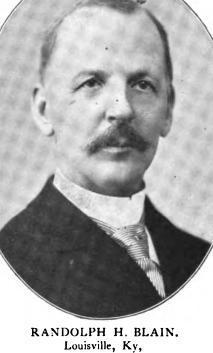 BATTLE UNIT NAME: Jackson's Company, Virginia Horse Artillery (2nd Organization 1863-65)
BATTLE UNIT NAME: Jackson's Company, Virginia Horse Artillery (2nd Organization 1863-65)
SIDE: Confederacy
COMPANY:
SOLDIER'S RANK IN: Senior First Lieutenant
SOLDIER'S RANK OUT: Senior First Lieutenant
ALTERNATE NAME:
FILM NUMBER: M382 ROLL 5
PLAQUE NUMBER:
NOTES: Company Note - Capt. Jackson's Company
BATTLE UNIT NAME: G.B. Chapman's Company, Virginia Light Artillery (Monroe Battery)
SIDE: Confederacy
COMPANY:
SOLDIER'S RANK IN: Captain
SOLDIER'S RANK OUT: Captain
ALTERNATE NAME:
FILM NUMBER: M382 ROLL 10
PLAQUE NUMBER:
NOTES: none
BATTLE UNIT NAME: McClanahan's Company, Virginia Horse Artillery
SIDE: Confederacy
COMPANY:
SOLDIER'S RANK IN: Captain
SOLDIER'S RANK OUT: Captain
ALTERNATE NAME:
FILM NUMBER: M382 ROLL 36
PLAQUE NUMBER:
NOTES: none
.svg)
.png)
